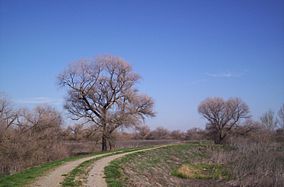San Luis National Wildlife Refuge facts for kids
Quick facts for kids San Luis National Wildlife Refuge |
|
|---|---|
|
IUCN Category IV (Habitat/Species Management Area)
|
|

North levee, San Luis Refuge - March, 2007
|
|
| Location | Merced County, California, United States |
| Nearest city | Los Banos, California |
| Area | 26,600 acres (108 km2) |
| Established | 1966 |
| Governing body | U.S. Fish and Wildlife Service |
| Website | San Luis National Wildlife Refuge |
The San Luis National Wildlife Refuge is a special place in central California. It's a huge home for many migratory birds, especially waterfowl (birds that live near water). These birds fly long distances every year. The refuge gives them a safe place to rest and find food during winter.
Contents
Discover San Luis National Wildlife Refuge
A Special Home for Wildlife
The San Luis National Wildlife Refuge is located in the San Joaquin Valley. This area has many different natural spaces. You can find tree-lined channels and oxbows. These are curved lakes that used to be part of a river. The refuge also has many wetlands and native grasslands.
The refuge was created in 1966. It covers about 26,600 acres, which is like 20,000 football fields! It is managed by the United States Fish and Wildlife Service. Their job is to protect wildlife and their homes.
Why Wetlands Are Important
Thousands of acres of wetlands at the refuge are carefully managed. They use a system of canals to bring water to these areas. This helps grow natural food for the many migratory waterfowl. It's like a giant pantry for the birds!
The refuge also has some of the best native grasslands left in the Central Valley. These areas include shrubs and special pools called vernal pools. Vernal pools fill with water in the wet season and dry up later. They are home to unique plants and animals.
Amazing Animals at the Refuge
Many different kinds of birds come to the San Luis Refuge. You can see thousands of mallards, pintails, green-winged teals, and ring-necked ducks. They all gather in the managed wetlands. The wood duck also lives here, often found among the trees along the water channels.
Other birds like Herons and egrets build their nests in the big oak and willow trees. They find lots of food in the refuge, like frogs and crayfish. You can also spot many different songbirds, hawks, and owls using the refuge as their home.
Protecting a Special Elk
The refuge is also home to a herd of tule elk. These are a special kind of elk. They are the smallest type of American elk. Tule elk were once endangered, meaning they were at risk of disappearing forever. They were brought back to the refuge to help their numbers grow. This helps protect them for the future.


